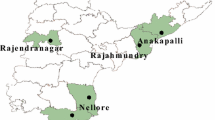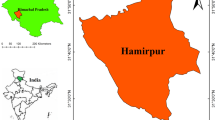Abstract
Meteorological and lysimetric data for a period of nine years were used to develop crop coefficients for rice grown under lowland conditions in a sub-humid tropical climate in India. The estimated crop coefficients were found to be higher than those values recommended by FAO. A crop coefficient model with basal coefficient, moisture availability coefficient and surface wetness coefficient terms has been proposed and found suitable. On most counts, the moisture availability coefficient was found to be near unity and the wetness coefficient was found to be significant. The basal crop coefficients for lowland rice have also been presented for practical use with the proposed models.
Similar content being viewed by others
References
Abdulmumin S. & Misari S.M. 1980. Crop coefficients of major crops of the Nigerian semi-arid tropics.Agric. Water Management 18: 159–171.
Arumugam N. & Mohan S. 1994. Estimation of stagewise crop coefficients for major crops. Submitted toJournal of Indian Water Resources Society.
CBIP. 1991. Irrigation scheduling with limited water supplies. Central Board of Irrigation & Power Publication No. 218, New Delhi, India, 108p.
FAO. 1977. Guidelines for predicting crop water requirements. In: Doorenbos J. & Pruitt W.O. (Eds.). FAO Irrigation and Drainage Paper No. 24. Food and Agricultural Organization of the Unites Nations, Rome, Italy.
Elliott R.L., Harp S.L., Grosz G.D. & Kizer M.A. 1988. Crop coefficients for peanut evapotranspiration.Agric. Water Management 15: 155–164.
Engel B.A., Lembke W.D., Sipp S.K. & Goetsch W.D. 1989. Irrigation crop coefficients for Illinois corn.Trans. ASAE 32(4): 1275–1280.
Gupta R.K., Chauhan H.S. & Singh R.V. 1986. Estimation and prediction of evapotranspiration of paddy crop using climatic data.Jl. of Institution of Engineerings (India)-AG 67: 90–93.
Hargreaves G.H. & Samani Z. 1985. Reference crop evapotranspiration from temperature.Appl. Engrg. in Agric., ASAE 1(2): 96–99.
Hussein A.S.A. & ElDaw A.K. 1989. Evapotranspiration in Sudan Gezira irrigation scheme.J. Irrig. and Drain. Engrg., ASCE 115(6): 1018–1033.
Jensen J.R. & Rahman M.M. 1987. A semi-empirical model for calculating evaporation and transpiration from wetland rice.Agric. Forest Meteorol. 41: 289–306.
Jensen M.E., Burman R.D. & Allen R.G. (Eds.) 1990. Evapotranspiration and irrigation water requirements. ASCE Manuals and Reports on Engineering Practice. No. 70, Irrigation & Drainage Engineering Division, ASCE, NY, USA, 332p.
Lewis J.E. & Ndolo I.J. 1987. Estimating moisture availability for rice cultivation in Mwea, Kenya.Agric. Forest Meteorol. 41: 87–95.
Lourence F.J. & Pruitt W.O. 1971. Energy balance and water use of rice grown in the central valley of California.Agron. J. 63: 827–832.
Mohan S. & Prasad R. 1990. Studies on evapotranspiration models. Research Report No. WR1, Department of Civil Engineering, Indian Institute of Science, Bangalore, India.
Mohan S. 1991. Intercomparison of evapotranspiration estimates.Hydrol. Sci. J. 36(5): 447–460.
Mohan S. & Arumugam N. 1994. Crop coefficients for major crops in South India.Agric. Water Management, Accepted (In press).
Monteith J.L. 1973. Principles of environmental physics. Edward Arnold, London, 241p.
Ponnambalam K. 1987. Optimization of the integrated operation of multi-reservoir irrigation systems. Ph.D Thesis, University of Toronto, Canada.
Rao A.S., Thomas R. & Prabha H. 1988. Evapotranspiration rates of rice varieties Culture-20 and Pattami-20 in a humid tropical climate.Mausam 39(1): 111–112.
Research Group on Evapotranspiration. 1967. Evapotranspiration from paddy field.J. Agric. Meteorol., Tokyo 4–22: 149–158.
Reuss J.O. 1980. Matching cropping systems to water supply using an integrative model. Water Management Technical Report. 62, Water Management Research Project, Colorado State University, Fort Collins, Colorado, USA.
Sahu S.K., Dholbehera M.M., Senapathi S.C. & Sharma S.D. 1989. Establishment of a model for evapotranspiration from pan evaporation for upland paddy.Ind. J. of Power and River Valley Development 237–240.
Sarker R.P. 1981. Sunshine and solar radiation over India. India Meteorological Department Report, IMD Press, Pune, India.
Subramaniam A.R. & Rao S.A. 1985. Prediction of evapotranspiration of some crops under semiarid and sub-humid climates.Mausam 36(1): 67–70.
Tomar V.S. & O'Toole J.C. 1980. Water use in lowland rice cultivation in Asia: A review of evapotranspiration.Agric. Water Management 3: 83–106.
Walpole R.E. & Myer R.H. 1978. Probability and statistics for engineers and scientists. Macmillan Pub. Co., Inc: New York.
Wright J.L. & Jensen M.E. 1978. Development and evaluation of evapotranspiration models for irrigation scheduling.Trans. ASAE 21(1): 88–96.
Wright J.L. 1982. New evapotranspiration crop coefficients.J. Irrig. and Drain. Engrg., ASCE 108(IR1): 57–75.
Author information
Authors and Affiliations
Rights and permissions
About this article
Cite this article
Mohan, S., Arumugam, N. Irrigation crop coefficients for lowland rice. Irrig Drainage Syst 8, 159–176 (1994). https://doi.org/10.1007/BF00881016
Accepted:
Issue Date:
DOI: https://doi.org/10.1007/BF00881016




